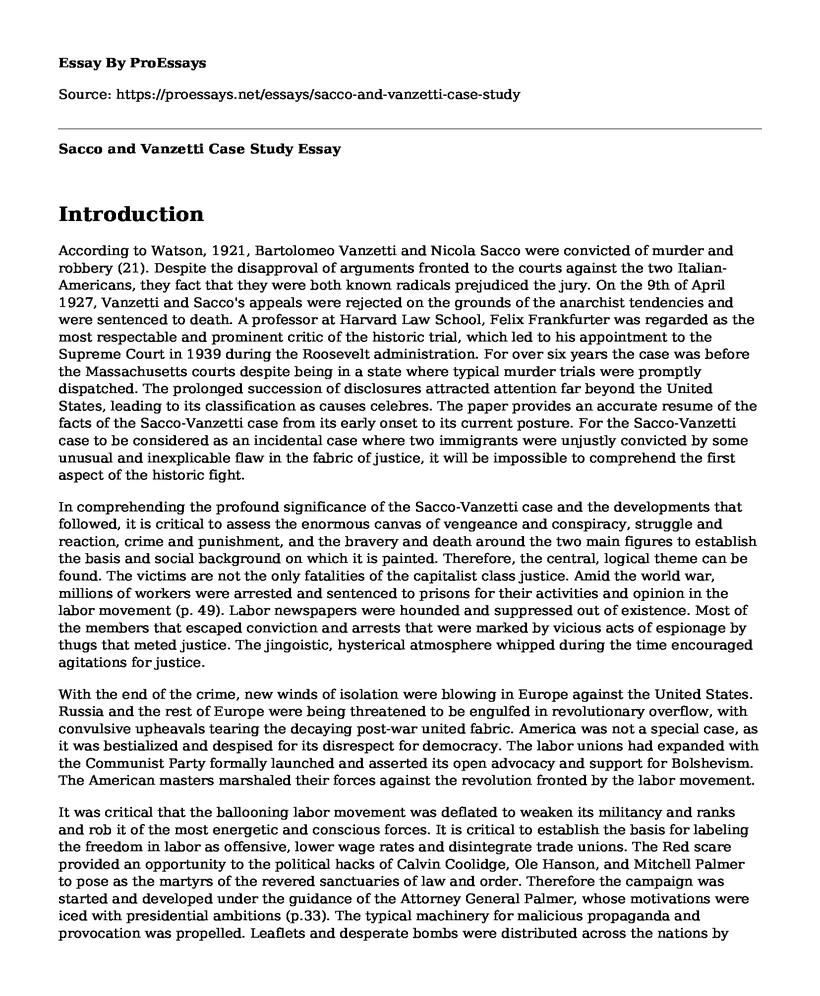Introduction
According to Watson, 1921, Bartolomeo Vanzetti and Nicola Sacco were convicted of murder and robbery (21). Despite the disapproval of arguments fronted to the courts against the two Italian-Americans, they fact that they were both known radicals prejudiced the jury. On the 9th of April 1927, Vanzetti and Sacco's appeals were rejected on the grounds of the anarchist tendencies and were sentenced to death. A professor at Harvard Law School, Felix Frankfurter was regarded as the most respectable and prominent critic of the historic trial, which led to his appointment to the Supreme Court in 1939 during the Roosevelt administration. For over six years the case was before the Massachusetts courts despite being in a state where typical murder trials were promptly dispatched. The prolonged succession of disclosures attracted attention far beyond the United States, leading to its classification as causes celebres. The paper provides an accurate resume of the facts of the Sacco-Vanzetti case from its early onset to its current posture. For the Sacco-Vanzetti case to be considered as an incidental case where two immigrants were unjustly convicted by some unusual and inexplicable flaw in the fabric of justice, it will be impossible to comprehend the first aspect of the historic fight.
In comprehending the profound significance of the Sacco-Vanzetti case and the developments that followed, it is critical to assess the enormous canvas of vengeance and conspiracy, struggle and reaction, crime and punishment, and the bravery and death around the two main figures to establish the basis and social background on which it is painted. Therefore, the central, logical theme can be found. The victims are not the only fatalities of the capitalist class justice. Amid the world war, millions of workers were arrested and sentenced to prisons for their activities and opinion in the labor movement (p. 49). Labor newspapers were hounded and suppressed out of existence. Most of the members that escaped conviction and arrests that were marked by vicious acts of espionage by thugs that meted justice. The jingoistic, hysterical atmosphere whipped during the time encouraged agitations for justice.
With the end of the crime, new winds of isolation were blowing in Europe against the United States. Russia and the rest of Europe were being threatened to be engulfed in revolutionary overflow, with convulsive upheavals tearing the decaying post-war united fabric. America was not a special case, as it was bestialized and despised for its disrespect for democracy. The labor unions had expanded with the Communist Party formally launched and asserted its open advocacy and support for Bolshevism. The American masters marshaled their forces against the revolution fronted by the labor movement.
It was critical that the ballooning labor movement was deflated to weaken its militancy and ranks and rob it of the most energetic and conscious forces. It is critical to establish the basis for labeling the freedom in labor as offensive, lower wage rates and disintegrate trade unions. The Red scare provided an opportunity to the political hacks of Calvin Coolidge, Ole Hanson, and Mitchell Palmer to pose as the martyrs of the revered sanctuaries of law and order. Therefore the campaign was started and developed under the guidance of the Attorney General Palmer, whose motivations were iced with presidential ambitions (p.33). The typical machinery for malicious propaganda and provocation was propelled. Leaflets and desperate bombs were distributed across the nations by provocateur agencies together with the joint effort of the detective and police forces of the federal government. Provocateurs and spies were integrated into labor organizations through the effort of the Department of Justice. The pulpit, the press, the movies, and schools were populated with the false propaganda and obvious lies about the radicals and the labor movements. During the war, anarchists were always policed by dozens of German agents, whose sole objective were to dismantle the labor movements.
The working class, a class that Vanzetti and Sacco belonged, fought a good fight for the lives of the two sacrificed colleagues, but its unpreparedness and weaknesses ended in a defeat. The bitterness that surrounded the defeat was channeled into the determination to battle upward for victory. Vanzetti and Sacco were the uncommon spirits in the labor movement, and their loyalty and heroism will continue to be cherished by the working class. The working class can only harbor burning hatred for the culprits that killed the two martyrs. The martyrs of the labor movement have a deeply rooted love and admiration for their unselfish acts. The hateful memory of Sacco and Vanzetti is the black background of the civil rights movement that will remain a shining burner of the motivation and inspiration for the future and present. The lengthy series of revelations will continue to attract the attention in the justice system and serve as an important learning lesson. For the Sacco-Vanzetti case to be considered as an incidental case where the unusual and inexplicable flaw in the fabric of justice was used to convict the innocent, it will be impossible to comprehend the first aspect of the historic fight.
References
Watson, Bruce. Sacco and Vanzetti: The Men, the Murders and the Judgment of Mankind. New
York: Penguin Books, 2008.
Cite this page
Sacco and Vanzetti Case Study. (2022, Nov 20). Retrieved from https://proessays.net/essays/sacco-and-vanzetti-case-study
If you are the original author of this essay and no longer wish to have it published on the ProEssays website, please click below to request its removal:
- Justice: What's the Right Thing to Do?
- National Crime Victims Survey Analysis Paper Example
- Essay Sample on Violation of Human Rights
- The Sovereignty of Divine Law Over Civil Law in Antigone: Critical Essay Sample
- Essay on SBU Fundamentals: Macroeconomic Dimensions for Business Strategy
- Essay Sample on Protecting Free Speech: A Necessary Human Right
- Research Paper on Racial Disproportionality in Criminal Justice System: Causes and Impacts







